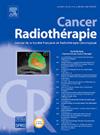首次使用适应性盆腔放疗系统的经验:治疗时间和学习曲线的分析
IF 1.4
4区 医学
Q4 ONCOLOGY
引用次数: 0
摘要
瓦里安Ethos系统不仅可以在治疗台上调整计划,还可以在人工智能的帮助下实现自动轮廓。本研究评估了适应性骨盆放疗系统的初步临床实施,重点关注治疗时间和相关的学习曲线。材料和方法我们分析了本中心903例连续治疗的大多数泌尿生殖系统癌的数据。治疗时间从用于重新规划的第一次锥形束计算机断层扫描时间计算到治疗结束。为了计算治疗是否随着时间的推移而普遍缩短,我们将第一次治疗的日期分为3个月的四分位数。使用t检验计算组间差异。结果从首次锥形束ct扫描到治疗结束的平均时间为25.9 min(标准差为6.9 min)。治疗时间取决于计划靶体积的数量和盆腔淋巴结的治疗。如果盆腔淋巴结得到治疗,从锥束计算机断层扫描到治疗结束的平均时间要长37%,如果有两个以上的计划靶体积,则要长26%。有一条学习曲线:在线性回归分析中,治疗月份的两个四分位数(优势比[OR]: 1.3, 95%可信区间[CI]: 1.8-0.70, P <;0.001)和计划目标卷数量(OR: 3.0, 95% CI: 2.6-3.4, P <;0.001)预测治疗时间。结论约三分之二的治疗在33 min内完成,治疗时间与单独计划靶体积的数量密切相关。这是一个持续的学习曲线。本文章由计算机程序翻译,如有差异,请以英文原文为准。
First experiences with an adaptive pelvic radiotherapy system: Analysis of treatment times and learning curve
Purpose
The Varian Ethos system allows not only on-treatment-table plan adaptation but also automated contouring with the aid of artificial intelligence. This study evaluates the initial clinical implementation of an adaptive pelvic radiotherapy system, focusing on the treatment times and the associated learning curve.
Material and methods
We analyzed the data from 903 consecutive treatments for most urogenital cancers at our center. The treatment time was calculated from the time of the first cone-beam computed tomography scan used for replanning until the end of treatment. To calculate whether treatments were generally shorter over time, we divided the date of the first treatment into 3-months quartiles. Differences between the groups were calculated using t-tests.
Results
The mean time from the first cone-beam computed tomography scan to the end of treatment was 25.9 min (standard deviation: 6.9 min). Treatment time depended on the number of planning target volumes and treatment of the pelvic lymph nodes. The mean time from cone-beam computed tomography to the end of treatment was 37 % longer if the pelvic lymph nodes were treated and 26 % longer if there were more than two planning target volumes. There was a learning curve: in linear regression analysis, both quartiles of months of treatment (odds ratio [OR]: 1.3, 95 % confidence interval [CI]: 1.8–0.70, P < 0.001) and the number of planning target volumes (OR: 3.0, 95 % CI: 2.6–3.4, P < 0.001) were predictive of treatment time.
Conclusion
Approximately two-thirds of the treatments were delivered within 33 min. Treatment time was strongly dependent on the number of separate planning target volumes. There was a continuous learning curve.
求助全文
通过发布文献求助,成功后即可免费获取论文全文。
去求助
来源期刊

Cancer Radiotherapie
医学-核医学
CiteScore
2.20
自引率
23.10%
发文量
129
审稿时长
63 days
期刊介绍:
Cancer/radiothérapie se veut d''abord et avant tout un organe francophone de publication des travaux de recherche en radiothérapie. La revue a pour objectif de diffuser les informations majeures sur les travaux de recherche en cancérologie et tout ce qui touche de près ou de loin au traitement du cancer par les radiations : technologie, radiophysique, radiobiologie et radiothérapie clinique.
 求助内容:
求助内容: 应助结果提醒方式:
应助结果提醒方式:


